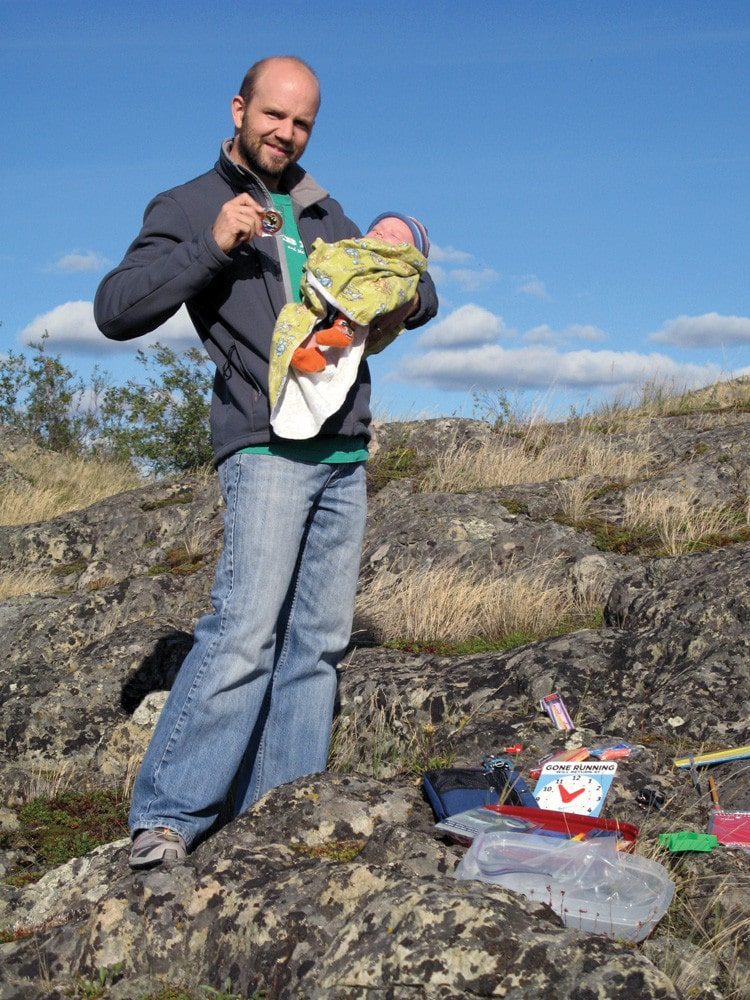The scoop on geocaching in YK
story and photo by Sarah Marsh
The first time I went geocaching, it was the middle of January and I had pretty much slept away the first half of the winter (being pregnant can do that to a girl)! But by the time the New Year rolled around, something in me snapped – the doc called it “starting your second trimester” – and I had a ton of energy and couldn’t bear the thought of taking one more nap.
The sky was cloudy and the mercury had dropped to -38 Celsius, but I didn’t care; I needed to get outside. That’s when my husband, Troy, suggested geocaching. I’d heard the term before and had a vague notion that it was “modern day treasure hunting.” I was pretty keen, but needed more details.
Troy explained it better: “a person makes and hides a cache (essentially a container filled with random items) anywhere in the world. They note its latitude and longitude coordinates using a GPS device, then post the geocache’s location online. Anyone with a GPS or GPS-enabled smartphone can find it, and when they do, they write in the cache’s log book, take an item and leave something in its place.”
Troy Googled “geocaching” and found geocaching.com. He created a profile, entered our postal code and Voila! Up popped about five or six geocaches hidden around the city. Soon, Troy had installed an app from the geocaching website and uploaded the caches’ coordinates onto his GPS. He could’ve entered them manually, but if “there’s an app for that,” he’ll use it!
We decided to check out the closest cache, hidden on the Niven Lake Trail. After half an hour of searching, digging and climbing in the blistery cold, we gave up. We couldn’t find it, but that didn’t stop us – it only made the hunt more alluring. We came back a few months later when the snow had melted, and after 10 minutes of snooping suspiciously around the Niven Lake bridge, we found it!
It was a microcache – a super-small cache containing only a log sheet and a pencil – so we wrote our names, the date and a little note about our adventures finding the cache. We carefully packaged it back up, put it back into its hiding spot, and that was it! We took a few pictures of the cleverly hidden little parcel, and the smiles on our faces when we found it, and continued on our walk.
We’ve since found caches around the city, down the Ingraham Trail and on our travels south. Along the way, we’ve logged our visits, swapped our NWT-themed trinkets for treasures left by the geocachers before us, and found and re-hidden trackables – coins or tags that get moved from cache to cache with a tracking code so the owner can track its journey around the world.
We’ve introduced friends and family to the activity, and everyone has enjoyed their adventures. A few years ago, I even built a cache filled with all sorts of ‘sentimental’ goodies for my dad that he could hide for his 60th birthday. He thought it was pretty cool and hid it under a moose antler in the hills around Coal Lake, Yukon.
Geocaching’s been a great way to check out different parts of the city, the territory and the country – and it’s always rewarding, even if you don’t find the cache! The geocaches we’ve found are usually hidden somewhere pretty special, just off the beaten path, and while they don’t contain gold or jewels, there always seems to be something memorable about the adventure.
Our kids got handmade “treasure boxes” from my dad this summer and they seem to understand, without any explanation or YouTube video, the lure of treasure, no matter how big or small, the thrill of the hunt, and the satisfaction of discovery.
This past summer, we started thinking about making our own geocache. We’ve always been the “seekers” and never the “hiders,” so we’re looking forward to building and hiding something of our own.
YK’s Geocaching Scene
• There are more than 90 caches hidden around YK and the surrounding area, as well as more than 60 across the territory!
• It’s fun and easy – kid-friendly, senior-friendly, dog-friendly – everyone is doing it and you can do it year-round!
• It’s great for locals and visitors. In fact, visitors hide just as many caches here as locals.
Rules for hiding a cache around Yellowknife:
• Use a weather-proof container. Think waterproof and freezer-friendly!
• If you can, try to hide it in a spot that’s accessible year-round – if it’s hidden above “snow level,” we can find it in the winter!
• Don’t hide food, drugs or alcohol – animals have better noses than us and can destroy a cache in no time.
• Have fun with your cache – make a theme, get creative with the container and put some cool local swag in there – you’d be surprised how many travellers come here and find a cache or two on their visit!
Rules for finding a cache anywhere:
• If you take something, leave something of equal or greater value.
• Write about your find in the cache logbook.
• Place it back in the original hiding spot.
• Log your experience at geocaching.com.
You can start simple by finding one of the many “urban caches” right downtown – but be careful – it’s addictive! Before you know it, you’ll be in the middle of nowhere scaling granite walls, scouring the forest floor, leaving no rock unturned and getting up close and personal with your inner-pirate! Arrgh!
Learn more at geocaching.com. Happy caching!







